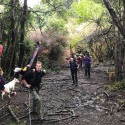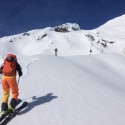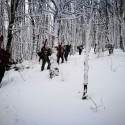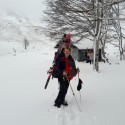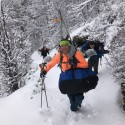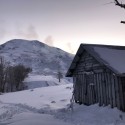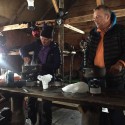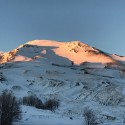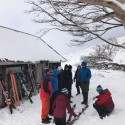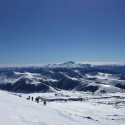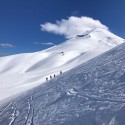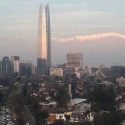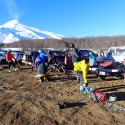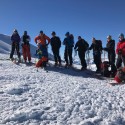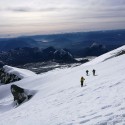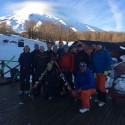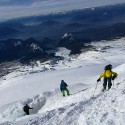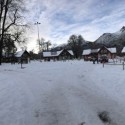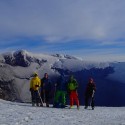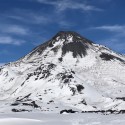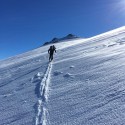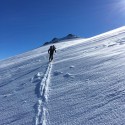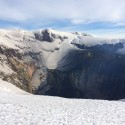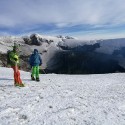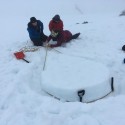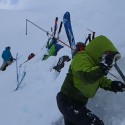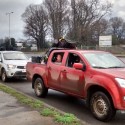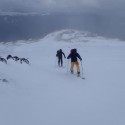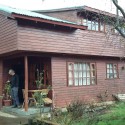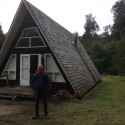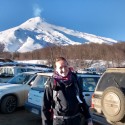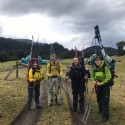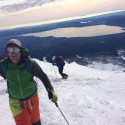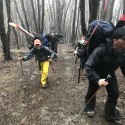EXPEDITION 1: Dates: 15th – 31st July 2017
Through July and August 2017, 28 enthusiastic participants, mostly deriving from HQ 2nd Medical Brigade, embarked on an adventure to the southern hemisphere, between latitudes 33’ and 41’ in the high Andes of Chile to conquer snow covered volcanoes on skis. It was broken down into two expeditions lasting 2 weeks each with similar itineraries, the expedition leader being WO1 Steve Ashcroft. The large majority of participants being Army Reserve, with a few Regulars, one Navy instructor and one student from Southampton OTC, the ages ranged from 20 to 57 years. Expedition participants included Nurses, Doctors, MSOs, Drivers, Radiologists, Biomedical Scientists, Civil servants to name a few trades, which meant medically we felt pretty safe in the remotest of locations. As a minimum level of competency everyone attending had to have already achieved the Ski Foundation 2 qualification, which incorporates ski touring alongside downhill Alpine Skiing and therefore, everyone had a level of proficiency on the piste with a survivable nature and determination for the off-piste parts!
It may have seemed a crazy idea that it was possible to ski up volcanoes however, the reality was that the volcanoes we conquered were mostly dormant but high and hence, could retain sufficient snow to allow a ski touring expedition. The aim of the expedition was to develop the individual’s leadership qualities, navigational skills, physical robustness, confidence and self- reliance through arduous ski touring undertaken in a number of remote wilderness areas. However, it also developed participants’ ability to empathise and tolerate living in close proximity to each other, looking after each other on the hill and also in the domestic duties of cooking and entertaining.
Acclimatisation phase.
After over half a day’s flight time and lack of sleep our first day in Santiago involved resting, re-packing and last minute purchases for those items that a few members had forgotten. Prices in Chile it seems are not dissimilar to the UK for all material and consumables, which was a surprise. Day 2 involved the long drive down to Las Trancas ski resort with the team split between 3 big 4 x 4 pickups, all squashed in and the kit bellowing out of the back we began to look like an expedition team. Las Trancas accommodation acclimatised us to the arduous environments we were to embark on, the only heat from a small wood burner, cold showers and blocked toilets but the morale never faltered as the excitement of getting on the snow and the start of the communal cooking kept spirits high.
Defensive skiing.
We were eased back onto the snow to regain ski legs with a day of downhill and instruction in two groups tackling on and off-piste sections. The following day the ski touring began and we were blessed with blue skies and sunshine, which combined with the uplift from the ski lifts, was a great beginning to the day. As people tested and adjusted their clothing with sweat pouring off we began to resemble Nordic skaters with all the Lycra and thin base layers. Looking up there was one volcano out of place without snow on its top; this was Volcan de Chilean 2457m which had a 3 km exclusion zone around it due to it still being active. We did wonder whether 3km gave us enough of a head start should it erupt but we placed our faith in the back-country authorities which we had to register with that morning, and ventured onto a nearby peak. The ski down was over immense rolling features and big bowl shaped slopes that were dusted in deep soft snow, which combined with the expansive view over the lowlands below, made the 4 hour tour uphill worthwhile.
The ski down in un-pisted powder with ever changing firmness was a wakeup call to even the most proficient skiers and it resulted in some interesting skiing styles. Unfortunately, from this challenge one of the team sustained an impressively bruised leg after making friends with the only protruding rock on the slope and another a twisted knee. All casualties made it back down by skiing but one, Victoria Bruce of 22 Field Hospital was to never don her skis again on the trip and hence she said, ‘My challenge was to now recognize and accept the injury and to become adaptable to take on a new role in the team, being useful by helping the expedition leader with logistics’.
Volcano Conquered.
We then moved onto Pucon, a small town by the edge of a lake with well-presented shops and coffee places. This time accommodation felt like a scene out of the Walton’s, as we slotted into crevices in the open plan chalet. It was warm and dry until the day of torrential rain when the limited space turned into a drying room.
Here a group of us conquered Volcan Villarica 2840m and once again being blessed with sunshine. We found as you move higher up the Volcano the winds increase, which adds rime ice to the undulating features and scours the slopes of loose snow leaving compacted neve. This provided a base of broken snow/ ice needles, which did not install much confidence in our grip, even when the ski crampons (Harscheisen) were deployed. Luckily the lenticular cloud that had been covering the summit lifted as we drew closer and we left skis to boot up the last section reaching the Volcano summit that was bellowing out steam…..a very unusual site. The ski down was enigmatic and straightforward and so this day, we took no casualties.
The weather had turned, the front came in and Chile blue sky turned into grey “just like Scotland” as our resident Scottish member Lt James Wood 205 Field Hospital liked to repeatedly point out. Surprisingly this didn’t seem to put off the locals (they must be as hardy as the Scottish) as they were back up on the slopes in the morning as were we. This day however, we stayed low and did a round robin of lessons. We played ‘find the transceiver’, ‘identify the snow pack layers’ and ‘belay someone safely down a steep slope’ using snow bollards and T-anchors.
Officer Cadet Barnabas Rex of Southampton UOTC felt this day had developed him. “I’ve acquired new survival skills that I can use in this terrain making me feel more confident”. He also went onto say about the whole expedition that “Never could I have imagined that I would be ski touring in Chile and hence this has broadened my horizons and inspired me with new ideas for adventures” which is quite impressive for someone who has spent his life traveling to remote locations with his family’s’ work.
The Big One.
We made our way further south to Anticura and onto Puyehue where for one night we slept in log cabins that had once been used by the Chilean army in the 1970’s, abandoned and then slowly resurrected by two Chileans into tourist accommodation. From here we were to depart for the mountain hut so we spent the evening packing our expedition equipment along with packing the food into two bags to be carried by the horse we were to hire. At 8am the following day we walked up to the hut in walking boots and hence our packs with all the ski gear and expedition gear were on the heavy side, making progress up the mountain slow going and energy sapping. The horse abandoned us at the snow line as its hooves were getting clogged with snow so three strong individuals hitched the packs on their shoulders and continued.
The hut was a small wooden shed containing 14 bunk-bed frames to sleep on, a bench and table and a wood burner. Jobs on arriving were to; collect the wood from the wood shed, make a path through the knee high snow to the long drop toilet, and collect the water which ended up proving to be the hardest as it was a yomp into a gulley and a balancing act over the river. The next day’s challenge! Puyehue Volcano 2240m was clearly seen from the hut so we took time over cups of tea outside to examine possible routes up it. Inside the hut the temperature dropped as the wood burnt down through-out the night however, the air was filled with snoring personnel and rustling sleeping bags which as one person described the sound being like “opening a packet of crisps with a chainsaw”.
The morning came with beautiful clear weather and after considerations and deliberations of challenge versus ability two of our team members decided to stay behind and hold the fort. Major Kelly Bennett from 201 Field Hospital was one of these and she explained what the expedition had given her. “I have a fear of being at heights and exposed so this expedition has made me challenge that and hence developed greater emotional intelligence as I have had to find ways to cope when the anxiety arises. I now have more empathy and understanding so when I am teaching as a Ski Leader 1 I will be able to recognise student fears and understand more off what they are going through on the slopes”.
We weaved our way in between bands of rock taking it in turns to route find. Our aim was to get to the top; ski round the rim and possibly into the crater however, 100m from the top the terrain was too icy, steep and unforgiving should one of us have a slip. We discussed it and decided to make our own summit where we stood. Skiing back down was adventurous and we made it within 100m of the hut before we had to ‘shuffle’ on skis. It was a great achievement and whilst away, our home-makers had done a wonderful job of tidying up the cramped living conditions in the hut and getting soup on for our return. The later afternoon lent itself to ski yoga, building a ski jump and of course….. Endless cups of tea as we marvelled at what we had achieved.
The adventure continued the next morning as we left the hut in the dark back to the valley bottom.
Our final challenge was heading back up north to Lonquimay ski resort, this time splitting into two groups. One group took on Volcan Lonquimay and the other CoCautlin. A sunny, blue-sky day but with high winds of 80km hour on the tops indicated the upcoming weather front. Due to winds the higher group abandoned the summit bid but not without a few long accidental slides down the slope as ski edges slipped on the scoured icy slopes. We learned from this that a ski pole dug into the slope can be a useful tool in preventing a slip to the bottom of the slope. Lt James Wood from 205 Field Hospital said “I have had to use everything I’d learnt in the first week on my Ski Foundation 3 but now in quite challenging conditions with the icy and windy summits. This experience has given me greater confidence to deal with adverse conditions when I do expeditions in my home country mountains of Scotland”. The other group achieved their summit but not without a few participants being taken to the edge of their ‘stretch zone’.
The expedition wrapped up with a cultural day in the capital city of Chile, Santiago taking it in on a bicycle tour and big thank you to our instructors Mark Howkins and Derek Clark who pushed us whilst keeping us safe. An expedition like this involves many planning days and a faith that it can be achieved, to which we owe this gratitude to WO1 Steve Ashcroft the Expedition Leader and the continued support that we have once again received from The Ulysses Trust.
Lt Sally Wrigley
203 Field Hospital
HQ 2 Medical Brigade
EXPEDITION 2: Dates: 29th July – 14th August 2017
A group of excited individuals, most of whom have never met before, gathered in an empty car park in Strensall Military Camp. Everyone was eagerly eyeballing the kit bags and estimating weights before loading them onto our hired minibus which would soon be bound for London Heathrow airport on the first leg of our journey to the Andean Mountains of central Chile.
After enduring a 18 hour flight to Santiago via Madrid we were met by our illustrious leader WO1 Ashcroft who proceeded to organise our tired bunch of travellers. We were the second group on this month long expedition and were taken to meet the outgoing group at the hotel which would be our base for our first night in Santiago. Hearing of the experiences of the first group this allowed our excitement to build. After a restful sleep our group split into 3 teams and we learned how to load our pick-up trucks before getting on the road.
Our first destination was Pucon, 780km south of Santiago. The last 30km drive to the village was stunning, with a view of our first Volcano, Volcan Villarrica, with the steam coming from the very top, covered in snow and ice with the picturesque Lake Villarrica at the foot of the mountain. Hard to believe how we were ever going to accomplish ski touring to the top of it!
the following three days included a multitude of activities. These activities included refresher on piste skiing to get “our legs” back in action after many days of travelling, technical ski touring techniques, avalanche risk awareness, building snow holes and emergency shelters and learning how snow packs are formed. This would ensure our safety as we ventured off piste into unknown environments. One team managed the exceptional task of getting to the very top of the Volcano after a long 13-hour day involving ski touring, using ski crampons and ice axes and a demanding off piste ski back down again. However, the jubilation and adrenaline rush at the top was worth every minute of the painful and arduous nature of the terrain. Fantastic team work!
Day 7 saw the expedition team move to Anticura in the midst of the beautiful Puyehue National Park. We climbed up to a mountain hut in the wilderness of Puyehue National Park where we lived for a few days to experience the remoteness, living on rations, dealing with the cold conditions, with the ultimate goal of attempting to summit Volcan Puyehue. The trek up was particularly strenuous due to the rough terrain, steep gradient of the volcano and carrying all of our kit for 3 days including skis and boots. We had some help from a hired local with 2 horses to carrying some essential food and cooking equipment to the snowline….after that we were on our own. Morale stayed high as it was a great experience with most individuals never having trekked out on skis to anywhere as remote as this before. The weather was unfortunately troublesome, very windy with poor visibility; however this did not hinder us, as we got our skis on the following morning after some hearty porridge and began the slow manoeuvre to the top of the Volcano. ¾ of the way up the team leaders made the difficult decision to get the emergency shelters out and turn back as the conditions were too dangerous and we returned to our little hut for tea.
The following morning, we skied and trekked off the volcano to meet the vehicles, have breakfast and start the long road journey to Lonquimay. This small winter town sits at 900m above sea level near the Corralco Mountain Resort, and was our base for tackling the arduous ridge ski tour to the top Volcan Lonquimay. We spent 2 days on this mountain range in challenging weather conditions which highlighted the importance of understanding mountain weather, and having the appropriate kit, equipment and avalanche safety kit.
After these exhausting tours, the team made the long drive back up to Santiago and spent a well-deserved R&R to experience the fantastic Chilean culture. It was a lovely time to unwind and laugh and talk about the bonding experiences that had just brought us all together over the last 2 weeks. After a long journey back to London Heathrow, fond farewells were made and parties separated in all directions and the majority made their way back to Strensall in order to ensure the kit was handed back in properly and accounted for.
As a Reservist this was an amazing experience and a fantastic opportunity made possible with the support of the Ulysses Trust. This support promotes the development of our Reservist, giving them the skills they need to become an efficient component of today’s Armed Forces.
It’s always sad to leave an amazing group of people with whom you have shared a once in a lifetime opportunity with. Returning to civilian life and NHS practice full of excitement and stories it simply inspires people to think about joining the Reserves…..and why wouldn’t it?!
Lt Col Duffy
201 Field Hospital

